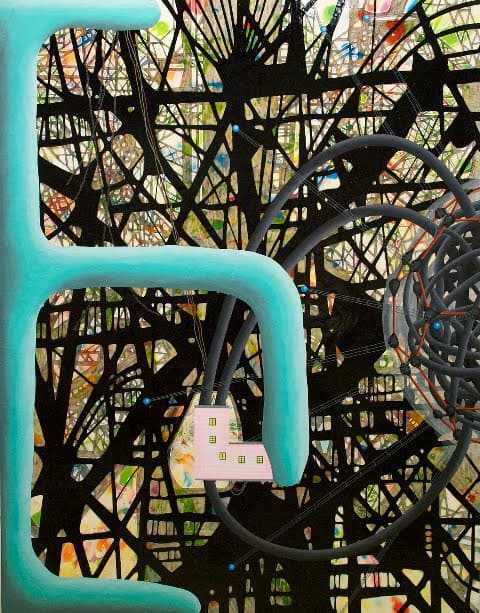
The first really noticeable thing about Peter Hildebrand’s paintings is their fostering of tensions: between the man-made and the organic, the neatly-limned and the wildly splodged. Against a background of drooled or spat-out paint, Hildebrand creates imaginary architectural structures, whose forms’ intricacies and details suggest vast, human-dwarfing scale. By turns recalling the spectacular fripperies of World’s Fair pavilions (dodecahedral structures out of Buckminster Fuller recur) or the grim blankness of corrective institutions (panopticons and H-blocks), Hildebrand’s loopy architectural fantasies seem wilfully unbuildable, like Antonio Sant’Elia’s impossible futurist buildings. The allusion to utopian modernist projects is of a piece with a strain in contemporary art that looks back at the failed visions of the last century like embarrassing family secrets, best kept hidden.
For Hildebrand, though, the modernist past is re-presented not as the materialisation of long-discredited political fantasy but as something stranger, wilder, and more irrational than orthodox readings might have us assume. In Hildebrand’s paintings, two apparently contradictory twentieth-century aesthetic and political movements are forcibly conjoined: the hard-edged asceticism of Bauhaus utopianism and the lurid gut-spilling of Surrealism at its most unbridled.
Take, for example, his painting Fuller’s Glitch – its title perhaps a reference to the aforementioned Buckminster. Layers of paint are superimposed like webs. Close-to, the work (like many of Hildebrand’s paintings) has the obsessive layering and horror vacui detailing of Chris Ofili’s paintings of the mid-1990s. A brain-like next of pipes confronts a giant E-shaped turquoise structure, from one of whose fronds a small pink modernist building emerges, like a thumb. Simultaneously galactic and microscopic, Hildebrand’s painting juxtaposes the inner life of the creative mind, feverishly cooking up impossible architectural solutions to insoluble societal problems, and the expanses of the universe beyond. The neural analogy is perhaps intentional: “buckyballs”, molecules of pure carbon shaped like Fuller’s geodesic domes, are a much pored-over issue in nanotechnology. The tension between the visible and invisible, the impossibly large and microscopically small, is part of what charges Hildebrand’s paintings with their weird urgency.
In Hildebrand’s Pentagonia, a five-sided building, evidently based on the Pentagon, is elevated on slender stilts against a spray of white paint. It glows, like a halo. Vaguely spaceship-like, it tilts threateningly overhead, its sides sparkling with pixellated windows. This is an uninhabitable space, a reminder of the etymology of Sir Thomas More’s Utopia (“no place”), a place comically uninterested in human access. Strutting on its spindly legs, like one of Dali’s disembodied heads on crutches, it seems unstable, somehow wobbly, like a dream leaving your mind.
- Originally ublished on Saatchi Online, 28 February 2011.